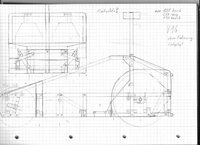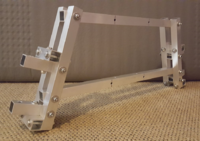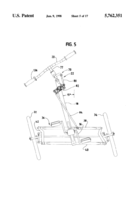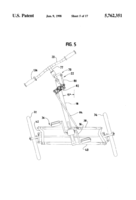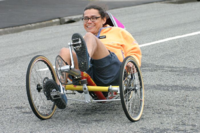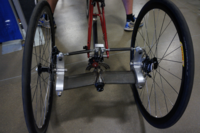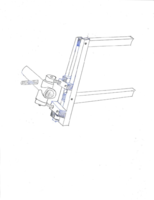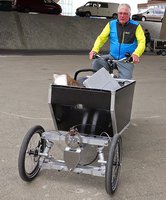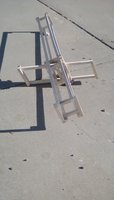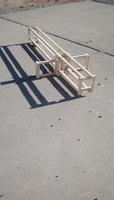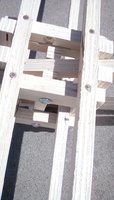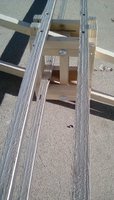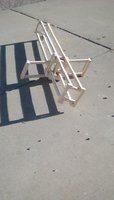Hello Titan Wolf, Hein and sheng fui,
I think maybe I'll post the American version of it on my blog at
https://dichotomyone.blogspot.com/.
and post the german version here in the Velomobilforum, to make it easier for the mostly German audience. It should be better for anyone who prefers German and the American version is just a click away.
Sheng fui will have to let me know if translation with deepl is better than with google translate, as that's what I used to translate most recently.
Wolf I have looked around and thought about your note and have a few more comments. I'm not sure I fully understand what you're up to, but I took a few things for granted when I came up with the idea of tipping. The first thing is that this harness would still be stuck between two sets of uprights and would not be able to move from front to back. Tilting would only occur through the YZ plane (X = left-right, Y = front-back, Z = top-bottom). The second thing is that there must be a way to move the tilt left and right. I think that your comment about adding the inclination to the steering system, as a kind of addition, extends to this point. I've been just keeping the tilt using a braking system during the movement to avoid exactly the problems you've noticed about the progressive instability of the wheels even when wobbling. There must be a controlled shift, side by side, tilt, unless there is a very unique self-balancing geometry imposed on the vehicle. I do not claim that this kind of incitement to these geometries. The following picture shows a cargo bike with tilting technology and braking system for it, but it has a tilting technology. The control is visible in the middle under the brake. There must be a controlled shift, side by side, tilt, unless there is a very unique self-balancing geometry imposed on the vehicle. I do not claim that this kind of incitement to these geometries. The following picture shows a cargo bike with tilting technology and braking system for it, but it has a tilting technology. The control is visible in the middle under the brake. There must be a controlled shift, side by side, tilt, unless there is a very unique self-balancing geometry imposed on the vehicle. I do not claim that this kind of incitement to these geometries. The following picture shows a cargo bike with tilting technology and braking system for it, but it has a tilting technology. The control is visible in the middle under the brake.
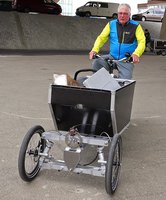
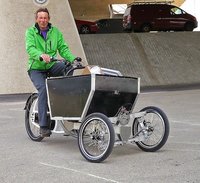
So my challenge is to find a way to integrate tilt control into the XYZ spaceframe system.
I have an insight you may have seen, and I have an insight that may have been obvious to others ...... If the wheels tip but the trike does not drive, will the trike be steerable at all? I think that the proposed tilting mechanism will not tilt the whole trike but only the wheels. Seems strange ... but that's the way it looks. I do not think that will work at all without the whole vehicle being able to tip over with the wheels. LOL ... that's how I learn.
What I also found in other tilting trikes is that some of them have used a dynamic spring and shock absorption system to keep the trike upright and metastable in normal use. The trike would tip over, but it took the force of a turn or a crooked event to make it tip over. That seems like a useful idea.
I may have made another sketch for another time with a better tilting additive for this trike. I hope that this jumble of thoughts makes sense.
So until the latter.
Ceeann
Translated with
www.DeepL.com/Translator
[DOUBLEPOST=1517694063][/DOUBLEPOST]Oops! Nun, das hat nicht funktioniert!
Vielleicht das nächste Mal......
[DOUBLEPOST=1517694185][/DOUBLEPOST]Hallo Titan Wolf, Hein und sheng fui,
Ich denke, vielleicht werde ich die amerikanische Version davon auf meinem Blog unter
https://dichotomyone.blogspot.com/ veröffentlichen.
und poste die deutsche Version hier im Velomobilforum, um den meist deutschen Zuschauern die Bedienung zu erleichtern. Es sollte besser für alle sein, die Deutsch bevorzugen und die amerikanische Version ist nur einen Klick entfernt.
Sheng fui wird mich wissen lassen müssen, ob die Übersetzung mit deepl besser ist als mit google translate, da dies das ist, was ich zuletzt für die Übersetzung verwendet habe.
Wolf Ich habe mich umgesehen und über Ihre Notiz nachgedacht und habe noch ein paar weitere Kommentare. Ich bin mir nicht sicher, ob ich völlig verstanden habe, was du da vorhast, aber ich habe ein paar Dinge für selbstverständlich gehalten, wenn ich die Idee zum Kippen präsentiere. Die erste Sache ist, dass dieses Trapez immer noch zwischen zwei Sätzen von Ständern gesteckt wäre und nicht in der Lage wäre, sich von vorne nach hinten zu bewegen. Das Kippen würde nur durch die Y-Z-Ebene erfolgen (X=links-rechts, Y=vorne-hinten, Z=oben-unten). Die zweite Sache ist, dass es eine Möglichkeit geben müsste, die Neigung nach links und rechts zu bewegen. Ich denke, dass Ihre Bemerkung über das Hinzufügen der Neigung zum Lenksystem, als eine Art Zusatz, bis zu diesem Punkt reicht. Ich habe mich nur mit dem Halten der Neigung unter Verwendung eines Bremssystems während der Bewegung beschäftigt, um genau die Probleme zu vermeiden, die Sie über die fortschreitende Instabilität der Räder selbst beim Wackeln bemerkt haben. Es muss eine kontrollierte Verschiebung, Seite an Seite, Neigung, es sei denn, es gibt eine sehr einzigartige selbstausgleichende Geometrie, die dem Fahrzeug auferlegt wird. Ich behaupte nicht, dass diese Art von Anstiftung zu diesen Geometrien. Das folgende Bild zeigt ein Lastenfahrrad mit Neigetechnik und Bremssystem dafür, aber es verfügt über eine Neigetechnik. Die Steuerung ist in der Mitte unter der Bremse sichtbar.
Meine Herausforderung besteht also darin, eine Möglichkeit zu finden, die Steuerung der Neigung in das XYZ Spaceframe-System zu integrieren.
Ich habe eine Einsicht, die Sie vielleicht gesehen haben, und ich habe eine Einsicht, die für andere offensichtlich gewesen sein könnte...... Wenn die Räder kippen, aber das Trike nicht fährt, wird das Trike überhaupt lenkbar sein? Ich denke, dass der vorgeschlagene Kippmechanismus nicht das ganze Trike, sondern nur die Räder kippen wird. Scheint merkwürdig... aber so sieht es aus. Ich glaube nicht, dass dies überhaupt funktionieren wird, ohne dass das ganze Fahrzeug mit den Rädern kippen kann. LOL... so lerne ich.
Was ich auch bei anderen Kipp-Trikes festgestellt habe, ist, dass einige von ihnen ein dynamisches Feder- und Stoßdämpfungssystem verwendet haben, um das Trike aufrecht und metastabil im normalen Gebrauch zu halten. Das Trike würde kippen, aber es brauchte die Kraft einer Drehung oder eines schiefen Ereignisses, um es zum kippen zu bringen. Das scheint eine nützliche Idee zu sein.
Ich habe vielleicht noch eine weitere Skizze für eine andere Zeit mit einem besseren Kippadditiv für dieses Trike gebaut. Ich hoffe, dass dieses Durcheinander von Gedanken einen Sinn ergibt.
Also bis letzteres.
Ceeann
Übersetzt mit
www.DeepL.com/Translator



